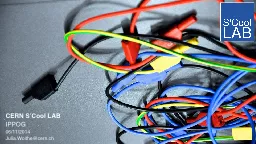

06112014 JuliaWoithecernch Outline CERN SCool LAB Where is it What is it Overview SCool LAB experiments How will it be used OutofSchool Learning Places 2 Where is it ID: 783361
Download The PPT/PDF document "CERN S’Cool LAB IPPOG" is the property of its rightful owner. Permission is granted to download and print the materials on this web site for personal, non-commercial use only, and to display it on your personal computer provided you do not modify the materials and that you retain all copyright notices contained in the materials. By downloading content from our website, you accept the terms of this agreement.
Slide1
CERN
S’Cool LABIPPOG06/11/2014Julia.Woithe@cern.ch
Slide2Outline - CERN S’Cool LAB
Where is it?What is it?Overview S’Cool LAB experiments How will it be used?Out-of-School Learning Places
2
Slide3Where is it?
3
143-R-003
Slide4What is it?
4
200 m
2
laboratory space
Phase
0
|
> 10 years
Phase
1
|
0
3-08 2013
Cleaning up
Phase
2
|
09-12 2013
Construction works
Phase
3 | 01-06 2014 Finishing constructionPhase 4 | since 07 2014 Development
watch the complete story! http://cds.cern.ch/record/1749319
Slide5Particle Acceleration
Basic Principles
Particle Detection
Braun tube
Hall-Effect
Cloud chambers
Specific charge
Rutherford
experiment*
Medipix
MX-10
Superconductivity
Spinthariscope
CosMO
*
Paul trap
model*
Franck-Hertz
KamioKannen
*
Planck's constant
X-ray unit
Radioactivity
PET (gamma spectroscopy)*
Overview S’Cool LAB experiments
5
School experiments in relation to CERN and its experiments 3 identical setups for all different experiments Supplier: PHYWE, LD Didactic, 3B Scientific, Jablotron, Netzwerk Teilchenwelt, CERN
… status 10/2014, some experiments * haven’t arrived yet
Slide6How will it be used?
6
CERN visitors - in total:
approx. 80 000 p. a
.
CERN
visitors - school students:
approx. 30 000 p. a
.
Participants
of CERN teacher
programmes
: approx. 1 000 p. a.Capacity of S’Cool LAB: approx. 3 600 p. a. (data from 01/09/13 – 01/09/14)How will it be used?► NOT AS VISIT POINT!
Distribution of visiting school groups by country(data from 01/09/13 – 01/03/14)
Slide7How will it be used?
To be used by pupils and teachers who come to CERN for more than half a dayBy the end of 2014: launch Website + application form + e-learning environmentSchool groups who want to discover the S’Cool LAB have to prepare themselves via our e-learning environment and have to take part in the impact research in physics educationOrganisation of activities:
7
introduction
E
A
E
B
E
C
E
A
E
B
E
C
E
A
E
B
E
Cdiscussion3 hoursmax. 36 students, 3 tutors
max. 4
students
m
ax.12 students, 1 tutorECECECEC … Experiment C
Slide8Out of School Learning Places
8Slide content provided byProf. Andreas Müller, University of Geneva
Slide9Out-of
-School Science Learning Places D-CH-EU
a boom all over Europe (the world)
Germany
LeLa
(=
Lernort
Labor)
,
N
(
2014)
=
322, N
Participants
/
a ≈ 400
000
Switzerland
M
@L (Marktplatz Außerschulische Lernorte)Europe Ecsitevery large ressouce for learningcomplementary to school
N
Labs
vs.
Year (LeLa)Ecsite members 2014Slide content provided byProf. Andreas Müller, University of Geneva
Slide10Out-of School Science Learning Places
Science Laboratories for pupils
S
cience
C
entres
Science
M
useums
...
How
to categorise?Theoretical background?
Slide content provided by
Prof. Andreas Müller, University of Geneva
Slide11How
to categorise?Some conceptual /
terminological
structure
Slide content provided by
Prof. Andreas Müller,
University of Geneva
dimensions
degree of informality
level of knowledge
location
duration
…
Slide12Informal STEM
landscapeJ.H. Falk, S.
Randol
, and L.D.
Dierking
. 2008. The Informal Science Education
Landscape
: A
Preliminary
Investigation. Washington, D.C.: Center for
Advancement
of Informal Science Education
Student laboratories
(
iPhysicsLab , MobiLLab
S’Cool
LAB)
Science “Shows”
ChimiScope
,
PhyisiScope
Science labs for pupils
(iPhysicsLab , MobiLLabS’Cool LAB)
Slide content provided byProf. Andreas Müller,
University of Geneva
Slide13Definition – students laboratory
Science Lab for Pupils, „Schülerlabor“Possibility to
explore
modern
science well equipped
laboratories
(high
tech
instruments
)young people explore science independently regular offers13http://www.lernort-labor.de/LabCards.php?tl=2
Slide14Theoretical
backgroundsucces factors: some research data -
pupils
success factors
(
Pawek
2009)
general factor: climate / quality of material / mentoring by tutors
contextual factors: link to the
everyday’s
life / authenticity
other important factor:
curricular links, in-school embedding
C. Pawek (2009): Schülerlabore
als interessefördernde außerschulische Lernumgebungen für Schülerinnen und Schüler aus der Mittel- und Oberstufe
Slide content provided by
Prof. Andreas Müller,
University of Geneva
Slide1515
Theoretical backgroundsuccess factors: some research data - teachers
LJ Hargreaves (1994): Attributes
of meaningful
field trip
experiences
Slide16Difficult!
Influenced by many factors16
time
PERSON
OBJECT
Priemer, B., & Pawek, C. (2014). Out-of-school STEM learning in Germany: Can we catch and hold students’ interest?. In 2014 NARST Annual International Conference CD. Pittsburgh, U.S.A.
Theoretical
background
Development of long-term interest
Slide1717
S’Cool LAB great opportunity challenging field for researchThank you for your attention!
Slide18S’Cool
LAB is looking for activity leaders!Are you a member of the CERN personnel and would you like to become a S'Cool LAB tutor? Subcribe to scoollab-info
or contact
scoollab-admin@cern.ch
!
18
http://
cds.cern.ch/journal/CERNBulletin/2014/35/News%20Articles/1749304